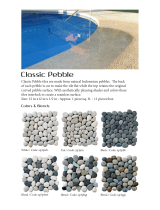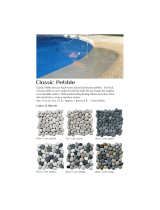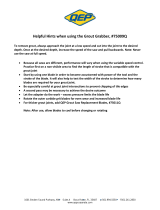
forms the visible surface. The profile’s 3/8"
(10 mm) radius makes DILEX-AHK/-PHK an
attractive option for countertop/backsplash
transitions, as it prevents the accumulation
of dirt and makes cleaning simple. The
profile separates tile fields that meet at
inside corners where limited movement
is expected. DILEX-AHK/-PHK prevents
surface water penetration and meets the
maintenance and hygienic requirements
of commercial kitchens, bathrooms,
and food-processing plants, or any tiled
environment where a sanitary cove base is
desired. DILEX-AHK is available in anodized
aluminum and textured color-coated
aluminum, while DILEX-PHK is made of
rigid PVC with a pre-colored, rigid PVC
cove section. Accessories for DILEX-AHK/-
PHK include: inside and outside corners,
connectors, and end caps. Outside corners
to integrate with Schluter
®
-QUADEC are
available for DILEX-AHK only.
4.22 Schluter
®
-DILEX-AHKA is an
anodized aluminum, cove-shaped profile for
transitions between walls to be tiled and
previously finished floors. The profile features
a single trapezoid-perforated anchoring leg
that is secured in the mortar bond coat and
a dovetailed channel, which can be bonded
to floor surfaces using Schluter
®
-KERDI-FIX,
epoxy resin, silicone, thin-set mortar, etc. A
3/8" (10 mm) radius cove section forms the
visible surface and prevents the accumulation
of dirt, making cleaning simple. DILEX-
AHKA prevents surface water penetration
and meets the maintenance and hygienic
requirements of commercial kitchens,
bathrooms, and food-processing plants, or
any tiled environment where a sanitary cove
base is desired. DILEX-AHKA integrates
with the DILEX-AHK and Schluter
®
-RONDEC
profiles at 90° inside and outside vertical
wall corners, respectively. Accessories for
DILEX-AHKA include 90° and 135° inside
and outside corners, and end caps.
4.15 Schluter
®
-DILEX-EHK features
trapezoid-perforated anchoring legs, made
of stainless steel, which are secured in the
mortar bond coat, and a stainless steel cove
section that forms the visible surface. The
profile’s 23/32" (18.5 mm) radius prevents
the accumulation of dirt and makes cleaning
simple. The profile separates tile fields
that meet at inside corners where limited
movement is expected.
4.15 Schluter
®
-DILEX-HKS features a
soft, thermoplastic rubber movement zone
that is attached to the profile via rigid rubber
grip bars to absorb larger movements at
floor/wall transitions and at inside wall
corners. DILEX-EHK and DILEX-HKS
prevent surface water penetration and meet
the maintenance and hygienic requirements
of commercial kitchens, bathrooms, food-
processing plants, and hospitals, or any
tiled environment where a sanitary cove
base is desired. Accessories for both
DILEX-EHK and DILEX-HKS include: inside
and outside corners, connectors, and end
caps. 90° outside mitered corner accessory
sets available for DILEX-HKS for ease of
installation.
Material Properties and
Areas of Application
DILEX profiles are resistant to most
chemicals encountered in tiled
environments. In special cases, the
suitability of a proposed type of profile must
be verified based on the anticipated
chemical, mechanical, and/or other stresses.
Exceptions and special considerations are
listed below:
Stainless steel profiles are roll-formed,
resulting in a slightly different contour
from those made of extruded brass or
aluminum. Stainless steel can sustain high
mechanical stresses and is particularly well
suited for applications requiring resistance
against chemicals and acids; for example
in the food industry, breweries, dairies,
commercial kitchens, and hospitals, as
well as in residential applications. Typically,
the profiles are formed using stainless
steel 304 (1.4301 = V2A). For more severe
chemical exposure, such as de-icing salts
and chemicals used in swimming pools,
we recommend the use of stainless steel
316 L (1.4404 = V4A), which offers even
higher corrosion resistance than the 304.
Even stainless steel cannot withstand all
chemical exposures, such as hydrochloric
acid, hydrofluoric acid or certain chlorine,
chloride and brine concentrations.
Aluminum profiles must be tested to
verify their suitability if chemical stresses
are anticipated. Cementitious materials,
in conjunction with moisture, become
alkaline. Since aluminum is sensitive
to alkaline substances, exposure to the
alkali (depending on the concentration
and duration of exposure) may result in
corrosion (aluminum hydroxide formation).
Therefore, it is important to remove mortar
or grout residue from visible surfaces.
In addition, ensure that the profile is solidly
embedded in the setting material and that
all cavities are filled to prevent the collection
of alkaline water.
Anodized aluminum profiles feature
an anodized layer that retains a uniform
appearance during normal use, but is not
color-stable in exterior applications. The
surface is susceptible to scratching and
wear and may be damaged by grout or
setting material. Therefore, these materials
must be removed immediately. Otherwise,
the description regarding aluminum applies.
Textured color-coated aluminum
is pretreated (chromated) aluminum
that is color-coated with a polyurethane
powder coat. The coating is color-stable,
UV-resistant, and suitable for exterior use.
Protect the profile against abrasion or
scratching.
Thermoplastic rubber inserts are highly
resistant to chemicals and can withstand
chemical stresses typically encountered
in tile coverings. The insert is resistant to
aging, weather, UV-rays, and ozone within
a temperature range of -76 °F (-60 °C) to
212 °F (100 °C). Thermoplastic elastomers
can be connected by welding if profiles are
joined to produce longer lengths.
CPE movement zones contain no softeners,
are UV-resistant, and can withstand
exposure to weather. They are resistant
to fungi and bacteria and are, therefore,
suitable for use around food. The CPE
material is also resistant to a number of
acids, alkalis, oils, greases, and solvents.
DILEX movement joint profiles with CPE
movement zones may be used in swimming
pools and the surrounding areas.
PVC movement zones are UV-resistant,
though not permanently color-stable, in
exterior applications. PVC profiles are
made of pre-colored, rigid PVC that resists
bending or scratching. The material is
UV-resistant, though not permanently
color-stable, in exterior applications.
Cutting Profiles
Observe all safety instructions and
standards as directed by the cutting tool
manufacturer, including protective eyewear,
hearing protection, and gloves.
Always measure carefully and dry fit the
profiles, corners, and connectors to ensure
proper fit and alignment prior to setting tile.
Plastic profiles may be cut using Schluter
®
-
SNIPS or similar. It is important to make sure
the blade is sharp to ensure a clean cut.
Aluminum profiles may be cut using any of
MOVEMENT JOINTS AND COVE-SHAPED PROFILES
5

























